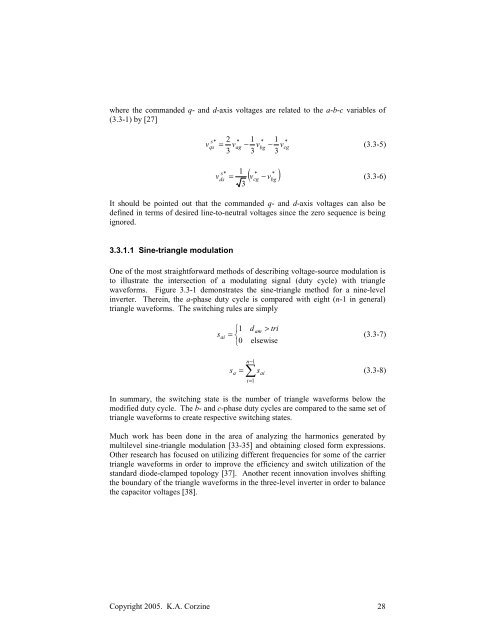Operation and Design of Multilevel Inverters Dr ... - MotorLab.com
Operation and Design of Multilevel Inverters Dr ... - MotorLab.com
Operation and Design of Multilevel Inverters Dr ... - MotorLab.com
Create successful ePaper yourself
Turn your PDF publications into a flip-book with our unique Google optimized e-Paper software.
where the <strong>com</strong>m<strong>and</strong>ed q- <strong>and</strong> d-axis voltages are related to the a-b-c variables <strong>of</strong><br />
(3.3-1) by [27]<br />
s*<br />
2 * 1 * 1 *<br />
vqs = vag<br />
− vbg<br />
− vcg<br />
(3.3-5)<br />
3 3 3<br />
* * ( v v )<br />
s*<br />
1<br />
vds = cg − bg<br />
(3.3-6)<br />
3<br />
It should be pointed out that the <strong>com</strong>m<strong>and</strong>ed q- <strong>and</strong> d-axis voltages can also be<br />
defined in terms <strong>of</strong> desired line-to-neutral voltages since the zero sequence is being<br />
ignored.<br />
3.3.1.1 Sine-triangle modulation<br />
One <strong>of</strong> the most straightforward methods <strong>of</strong> describing voltage-source modulation is<br />
to illustrate the intersection <strong>of</strong> a modulating signal (duty cycle) with triangle<br />
waveforms. Figure 3.3-1 demonstrates the sine-triangle method for a nine-level<br />
inverter. Therein, the a-phase duty cycle is <strong>com</strong>pared with eight (n-1 in general)<br />
triangle waveforms. The switching rules are simply<br />
⎧ 1 d am > tri<br />
sai<br />
= ⎨<br />
(3.3-7)<br />
⎩0<br />
elsewise<br />
∑ − n 1<br />
ai<br />
i=<br />
1<br />
s = s<br />
(3.3-8)<br />
a<br />
In summary, the switching state is the number <strong>of</strong> triangle waveforms below the<br />
modified duty cycle. The b- <strong>and</strong> c-phase duty cycles are <strong>com</strong>pared to the same set <strong>of</strong><br />
triangle waveforms to create respective switching states.<br />
Much work has been done in the area <strong>of</strong> analyzing the harmonics generated by<br />
multilevel sine-triangle modulation [33-35] <strong>and</strong> obtaining closed form expressions.<br />
Other research has focused on utilizing different frequencies for some <strong>of</strong> the carrier<br />
triangle waveforms in order to improve the efficiency <strong>and</strong> switch utilization <strong>of</strong> the<br />
st<strong>and</strong>ard diode-clamped topology [37]. Another recent innovation involves shifting<br />
the boundary <strong>of</strong> the triangle waveforms in the three-level inverter in order to balance<br />
the capacitor voltages [38].<br />
Copyright 2005. K.A. Corzine 28


